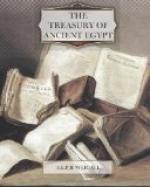Queen Tiy bore several children to the King; but it was not until they had reigned over twenty years that a son and heir was born, whom they named Amenhotep, that being changed later to Akhnaton. It is probable that he first saw the light in the royal palace at Thebes, which was situated on the edge of the desert at the foot of the western hills. It was an extensive and roomy structure, lightly built and gaily decorated. The ceiling and pavements of its halls were fantastically painted with scenes of animal life: wild cattle ran through reedy swamps beneath one’s feet, and many-coloured fish swam in the water; while overhead flights of pigeons, white against a blue sky, passed across the hall, and the wild duck hastened towards the open casements. Through curtained doorways one might obtain glimpses of a garden planted with flowers foreign to Egypt; and on the east of the palace the King had made a great pleasure-lake for the Queen, surrounded by the trees of Asia. Here, floating in her golden barge, which was named Aton-gleams, the Queen might look westwards over the tree-tops to the splendid Theban hills towering above the palace, and eastwards to the green valley of the Nile and the three great limestone hills beyond. Amenhotep III. has been rightly called the “Magnificent,” and one may well believe that his son Akhnaton was born to the sound of music and to the clink of golden wine-cups. Fragments of countless thousands of wine-jars and blue fayence drinking-vessels have been found in the ruins of the palace; and contemporary objects and paintings show us some of the exquisitely wrought bowls of gold and silver which must have graced the royal tables, and the charming toilet utensils which were to be found in the sleeping apartments.
While the luxurious Court rejoiced at the birth of this Egypto-Asiatic prince, one feels that the ancient priesthood of Amon-Ra must have stood aloof, and must have looked askance at the baby who was destined one day to be their master. This priesthood was perhaps the proudest and most conservative community which conservative Egypt ever produced. It demanded implicit obedience to its stiff and ancient conventions, and it refused to recognise the growing tendency towards religious speculation. One of the great gods of Syria was Aton, the god of the sun; and his recognition at the Theban Court was a source of constant irritation to the ministers of Amon-Ra.




